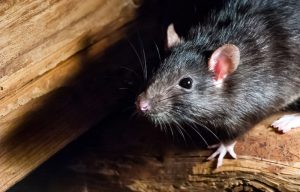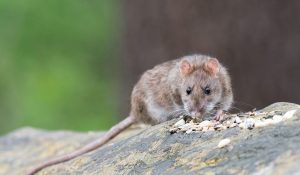Are you noticing roaches in areas like your kitchen cabinets, attic, or bathroom?
If so, it’s important to address the problem quickly. Roaches carry diseases, and they can quickly make your space unsanitary and unpleasant to live in.
Here at Smith’s Pest Management, we’ve helped homeowners throughout Northern California address pest problems for 15+ years.
In this post, we share our step by step guide on getting rid of cockroaches for good.
Key Takeaways
- To get rid of cockroaches in your house, locate their harborage areas, clean up and remove habitat and food sources, deploy roach treatment, use exclusion tactics to keep roaches from getting into your home, and monitor for decreased roach activity.
- To eradicate roaches as efficiently as possible, make sure you’re targeting your choice of treatment to the type of roach present in your home.
- Severe infestations will likely require the help of an expert pest management team.
Safety Considerations
- Gather your equipment. You’ll need a few tools to find cockroach hiding areas. These include a flashlight, a mechanic’s mirror, and a screwdriver or set of pliers to open hard-to-reach harborage areas.
- Collect PPE. If you’re planning to DIY pesticide applications, make sure to wear personal protective equipment like goggles, plastic or latex gloves, closed-toed shoes, long pants, and a long-sleeved shirt. In some cases, disposable coveralls may be ideal since they’ll protect your clothing and skin from pesticide contact.
- Read all pesticide label directions. Pesticides can be dangerous or even deadly. To apply them carefully, read and follow all label directions exactly.
How to Get Rid of Roaches: A Step-by-Step Guide
1. Identify the Roach
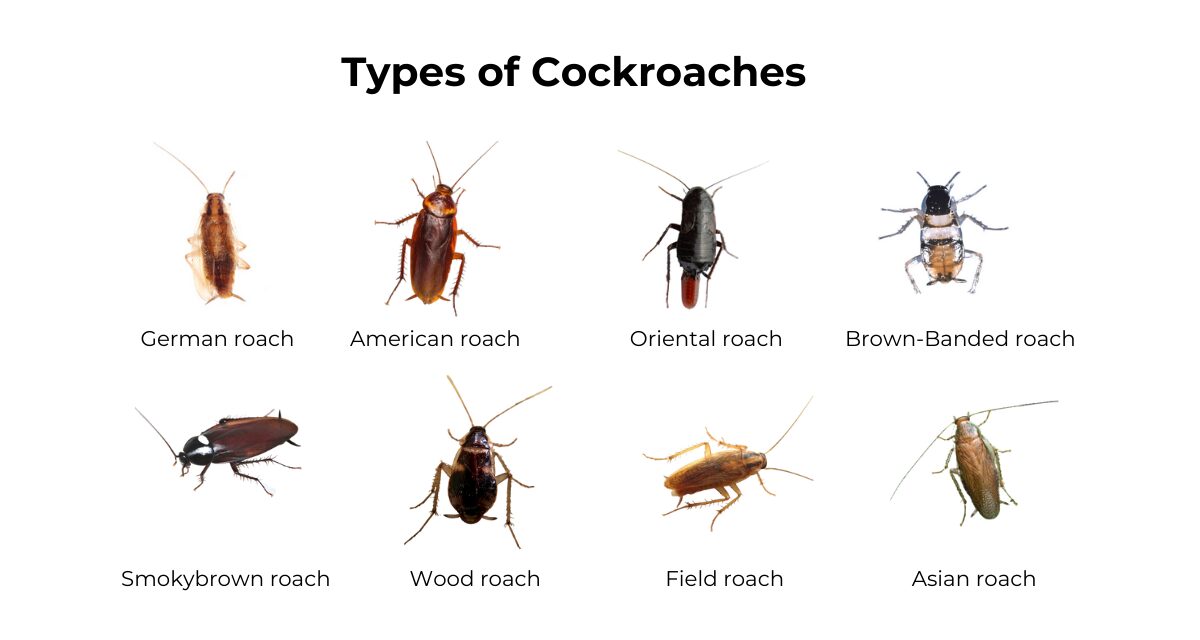
While roaches may seem similar, their habits vary widely from species to species.
Because of this, the only way to get rid of roaches effectively is to figure out what kind of roaches are in your home and target them accordingly.
Once you’ve determined which type of roaches are in your house, you can determine the best treatment option.
With that in mind, here’s an overview of the roaches you’re most likely to see indoors.
| Species | Appearance & Behavior | Treatment |
| German cockroach | Most common domestic cockroaches in the US. – Adults range from ½”-⅝” long.
Light brown with two dark, parallel stripes running down the body. These cockroaches breed rapidly – a single female can produce a cockroach infestation of more than 30,000 individuals in one year. German cockroaches are general feeders, but they prefer fermented foods like beer spills. |
Use bait station formulations containing abamectin, acetamiprid, fipronil, indoxacarb, imidacloprid, hydramethylnon, or boric acid.
Use a handheld vacuum cleaner to remove roaches from their harborage areas. Dump the roaches in the toilet and flush them after removal. Implement sanitation and exclusion tactics. Use residual insecticides containing pyrethroids, boric acid, or silica aerogel. If needed, add non-residual insecticides containing synergized pyrethrins or pyrethroids to provide quick knockdown. Apply insecticide dusts to dry areas like wall and cabinet voids. |
| American cockroach | The largest peridomestic species of cockroach that lives around humans.
Average lifespan of about two years. Sometimes called “sewer roaches” or “palmetto bugs.” They can reach 1-3” in length and tend to be brown or reddish-brown with light yellow edges around their bodies. |
Remove as much outdoor habitat as possible, including leaf and wood piles and thick layers of mulch.
Apply perimeter and barrier treatments containing residual pyrethroid insecticide formulations. Use residual insecticides containing chlorfenapyr, acetamiprid, or indoxacarb in harborage areas. Use gel baits in outdoor harborage sites. Implement sanitation and exclusion tactics, including screening and caulking gaps and cracks. |
| Oriental cockroach | Also referred to as “waterbugs,” “black beetles,” or “shad roaches.”
Found in all parts of the US. Total length is about 1 ¼” for females and 1” for males. Adults are dark brown-black with a greasy sheen to their bodies. These roaches feed on filth, trash, and decaying organic matter. |
Use the same kinds of insecticidal sprays and baits that are used for control of American cockroaches.
Apply perimeter or barrier treatments to the outside of buildings, paying special attention to plumbing and utility lines and entry points and the space beneath door and window jambs. Use caulking and screening to close access points. |
| Brownbanded cockroach | About 0.5” in length, dark brown in color.
Both males and females have light yellow bands on their wings and abdomens. They like dry areas and are common inside walls or electronics like televisions or refrigerators and inside attics and vents. |
Use a handheld vacuum cleaner to remove roaches from their harborage areas. Dump the roaches in the toilet and flush them after removal.
Use biological control methods, including parasitic wasps, to control outdoor populations of brownbanded cockroaches. Implement sanitation and exclusion tactics. Apply sprays and dusts labeled for brownbanded cockroaches to harborage areas like the shelves of clothes closets, inside of ceiling light fixtures, behind wall hangings, and inside dressers and bureaus. Consider hiring a pest management professional to apply contact, non-residual insecticides via fogging. |
| Smokybrown cockroach | Closely related to American cockroaches but are slightly smaller in size.
Adults are about 1” long and tend to be mahogany in color. These cockroaches feed on plant material, but can consume anything other cockroach species eat inside of houses or other buildings. Common in wood shingle roofs and gutters, which both provide ample organic matter for these roaches. Known to move in and out of buildings to forage more than other cockroach species. |
Implement sanitation and exclusion tactics.
Use the same residual sprays and baits that are recommended for the treatment of American cockroaches, paying special attention to crawlspaces, garages, attics, outdoor landscaping, and other harborage areas. Use dust formulations in attics and crawl spaces. Limit indoor moisture and humidity as much as possible. Place gel or paste baits near cockroach entry points. Consider hiring a pest management professional, since elimination of smokybrown cockroaches can be difficult and may require more extensive and prolonged treatments. |
| Wood cockroaches | “Wood cockroach” is a general term covering a number of cockroach species, including Parcoblatta pennsylvanica.
These cockroaches are usually less than ⅔” long. Common indoor pests when infested firewood is brought indoors. Especially prominent during the mating season, which runs from May to June. These cockroaches feed mostly on decaying organic matter. |
Implement sanitation and exclusion tactics.
Use residual insecticide sprays or dusts to treat the areas in your crawl space and beneath your home. Keep firewood stored away from the house. Use residual insecticide sprays around doors, windows, patios, and other areas where outdoor lights are located. |
| Field cockroach | Similar in appearance to the German cockroach but smaller in length.
Distinguishable by a black area on the head, which runs from the mouthparts to the eyes. Feeds largely on decomposing vegetation and normally lives outdoors, under stones or clumps of earth. May migrate inside during dry seasons of the year. Known to wander around indoors during the daylight hours. |
Remove decomposing vegetation outside the home.
Spray or dust infested areas with insecticides labeled to kill these cockroaches on contact. |
| Asian cockroach | Similar in appearance to the German cockroach.
Prefers to live in shady, moist areas outdoors. Known to be most active at dusk. Prefers to eat rotting vegetation and organic waste. |
Rake and remove leaf piles and other organic debris that may provide a hiding place for these cockroaches.
Reduce or eliminate bright lights both indoors and outdoors, or use filters to make them less attractive to roaches. Remove outdoor pet bowls and secure garbage cans. Use caulking, weather-stripping, and screening to seal entry points and harborage areas. Use residual insecticide sprays at entry points. Use cockroach scatter baits in outdoor areas where the cockroaches are living. |
2. Locate their harborage areas
The second step to getting rid of cockroaches is to locate and identify their harborage areas.
Here’s how:
- Focus your inspection at ground level. To find cockroaches, you have to think like a cockroach. Since cockroaches spend most of their life at floor level, that’s where you should begin your inspection. Generally speaking, cockroaches crawl around on the floor with their heads less than ¼” from the floor surface, so you’re likely to miss key harborage areas unless you get down on your hands and knees and look for them.
- Inspect outdoor habitats. Depending on the species of cockroach present, you may want to inspect affected outdoor areas, as well. Common habitats include trees, shrubs, landscaping ground cover, mulch, and locations near moisture sources like pools and pet dishes. Roaches may also live in wood piles, trashcans, rain gutters, and door and window casings. In moist climates, attics, garages, and crawl spaces are common roach habitats.
- Conduct a nighttime inspection. Some roaches are dormant during the day, and only come out to forage at night. With this in mind, use a yellow filter over your flashlight to search for cockroaches (especially German cockroaches) without scaring them.
Tip: If you still can’t identify roach harborage areas, contact a pest management professional for a more comprehensive roach survey.
3. Kill live roaches
If you see live roaches scurrying around your space, use a contact spray that contains ingredients like cypermethrin and imiprothrin, which provide instant knockdown for roaches. To use contact sprays safely, be sure to read and follow all label directions exactly.
For best results, hold the contact spray you’ve chosen about 12-18” from the roach and spray until the roach is wet. Never use contact sprays around exposed foods, utensils, or dishes. To avoid contact with fumes, keep kids and pets out of the area until the treated surfaces have dried.
Cockroaches also often hide in narrow spaces. With that being said, consider using flushing sprays.
These aerosol products can be sprayed into crevices to drive cockroaches out into the open, where they can be quickly vacuumed up, significantly reducing their population.
4. Clean up and remove roach habitat and food sources
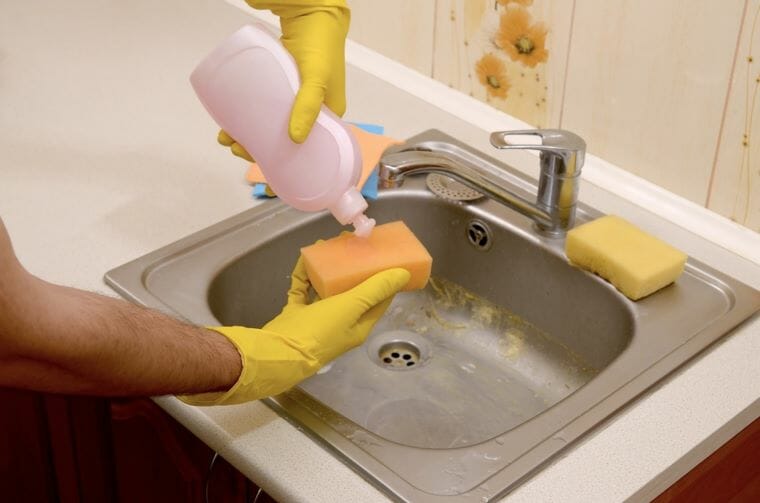
Once you’ve identified roach harborage areas, focus on removing their hiding places and food sources, both indoors and outdoors.
Keep in mind that cockroaches are drawn to your home — particularly your kitchen — due to the availability of moisture and food scraps.
Outside the house:
- Remove woodpiles, leaf piles, stagnant water, and overgrown underbrush.
- Secure lids to outdoor trash cans.
- Trim foundation plantings away from the home.
- Limit water sources by emptying standing water in pots and birdbaths.
- Reduce or remove outdoor pet food and bird feeders, which roaches may be feeding on.
- Use caulk, mesh screens, and other exclusion methods to keep cockroaches from entering the home.
- Remember that peridomestic species of roaches reproduce slowly, so trapping and other physical removal efforts will work better for these types of roaches than they will for species that reproduce more quickly, like German cockroaches.
- Use boric acid dusts and bait formulas since they are both effective and long-lasting.
Inside the house:
- Conduct regular roach inspection and monitoring to assess current levels of roach activity.
- Focus on cleaning, removal of food sources, and exclusion as the basis of all other control methods.
- Use roach traps and vacuuming to physically remove roaches.
- Use essential oil sprays and other “minimum risk pesticides” to kill roaches in your home.
- Use boric acid baits and dusts, which are effective and long-lasting.
- Use desiccating dusts like diatomaceous earth and silica aerogel in attics, crawlspaces, and wall voids.
- Use gel baits and bait stations to target large cockroach populations.
- Wash and put away all dirty dishes immediately after use.
- Clean up any crumbs and spills promptly.
- Empty sources of standing water, including pet bowls.
- Thoroughly clean up any plant-based materials as well as cardboard (which roaches love to eat!)
- Take out the garbage daily, and especially before going to bed at night.
- Mop and sweep the floors regularly, including under and around large appliances.
- Avoid leaving pet food out for an extended period.
- Store dry goods and pantry food in airtight glass or plastic containers.
- Store perishables in the refrigerator, and avoid leaving fruits and vegetables out on the counter.
- Keep the stovetop, dishwasher, and other cooking appliances clean. Pay special attention to areas like the drip pans under stove burners, the backsplash, and your garbage disposal.
- Wipe counters and tables after you cook each night. To add an additional layer of protection, add a few drops of lemon oil to your cleaning water. The scent of citrus will keep cockroaches from coming back.
- Recycle or get rid of old newspapers and used cardboard boxes as quickly as possible.
- If you have plumbing leaks in your home, fix them as quickly as possible.
- In addition to fixing leaks, regularly inspect sinks, refrigerators, appliances, and faucets to ensure they’re not leaking or producing excess moisture.
5. Deploy roach treatment
Non Toxic Treatments
If you’re looking for a chemical-free way to get rid of roaches, these are the best options:
| Treatment | How it Works | Pros and Cons |
| Diatomaceous Earth | Diatomaceous earth, or DE for short, is an excellent natural insecticide. Composed of pulverized, fossilized algae, DE’s particles are sharp and dehydrating. When roaches come into contact with DE, it damages their exoskeletons and dehydrates them to death.
Purchase some food-grade DE and sprinkle a light coating on any surface where you’ve noticed roach activity. |
Pros: Effective, affordable, safe for kids and pets
Cons: Messy, requires re-application, you will have to locate and dispose of dead roaches after each DE treatment |
| Baking Soda | Baking soda is one of the fastest, easiest ways to get rid of roaches – and it’s probably something you already have in your pantry. To make a DIY roach bait, dice a handful of onions and sprinkle them with baking soda.
Place this appetizer in a shallow dish anywhere you’ve noticed roach activity. When the roaches consume the baking soda, it creates gasses in the roaches’ stomachs, causing them to burst. |
Pros: Effective, non-toxic, affordable
Cons: Pets may consume the onion mixture (onions are toxic for dogs), messy, requires you to locate and dispose of dead roaches |
| Boric Acid | Boric acid is a naturally-occurring compound. A mixture of water and boron, it shows up in fruits and plants.
While boric acid is harmless to people and pets, it’s deadly for roaches. When cockroaches come into contact with boric acid, it sticks to their legs and wings. When they ingest the powder, it acts on the roach’s nervous and digestive systems – killing it rapidly. To use boric acid to get rid of roaches, sprinkle a light dusting onto a paper plate. Put an orange peel or spoonful of peanut butter in the middle of the plate and place the whole thing anywhere you’ve noticed roach activity. |
Pros: Effective, affordable, natural, non-toxic, easy
Cons: Can be messy, requires several applications or treatments, may not be ideal for homes with pets or young kids, requires you to track down and dispose of dead roaches |
| Borax | Borax is a readily-available laundry product that’s excellent for killing roaches. For best results, combine equal parts borax and white table sugar. Dust the mixture any place you’ve seen roach activity. When the roaches consume the borax, it will dehydrate them and kill them rapidly. | Pros: Effective, affordable, kills both adult and baby roaches
Cons: Can be messy, requires re-application, requires you to track down and remove dead roach bodies |
| Citrus | Citrus is a tasty treat for humans, but it’s a repellent to cockroaches. The smell of lemons, specifically, deters roaches. Add a few drops of lemon oil to the water you use to mop your floors. The scent won’t be detectable to people, but it will send roaches packing. | Pros: Effective, affordable, ideal for homes with kids and pets
Cons: Does not kill roaches – only deters them |
| Essential Oils | Essential oils are a great natural roach repellant. For best results, purchase peppermint or lemongrass essential oil and mix it with a bit of water. Spray the mixture anywhere you’ve seen roaches. Citrus, lime, oregano, and rosemary essential oils are generally recommended as the most effective and research-backed roach-repellent oils. | Pros: Effective, affordable, safe for kids and pets, non-toxic
Cons: Does not kill roaches |
Chemical Treatments
These are the best chemical control methods designed to target roaches:
| Treatment | How it Works | Pros and Cons |
| Glue Traps | Glue traps are a safe and effective way to identify roach problem areas and resolve infestations. Glue strips are sheets covered in a sticky substance. The smell of the trap lures roaches in and, once they step on the strip, the glue traps them.
For best results, place store-bought glue strips in any place you’ve noticed roach activity, including behind the refrigerator or under the sink. |
Pros: Effective, safe for kids and pets (as long as the strips are hidden), fast-acting
Cons: You must monitor strips for a few days or weeks and change and replace them when they become filled with dead roaches; glue strips won’t work for large roach infestations but can help monitor and control small infestations |
| Chemical Baits | What kills cockroaches almost instantly? Toxic baits. Today, there are a variety of effective cockroach bait formulations available.
If you’re targeting indoor roaches, granular, gel, paste, and aerosol foam baits can be effective. Bait station formulations containing abamectin, acetamiprid, fipronil, Indoxacarb, imidacloprid, hydramethylnon, or boric acid can also control species like the German cockroach. The key to using these baits effectively, however, is to place them directly into or very near harborage areas. If you’re targeting peridomestic cockroaches in attics or crawlspaces, granular bait formulations are the best bet, although you should be careful about using them alongside repellent insecticides like pyrethroids since the repellents can contaminate the bait and make roaches less likely to feed on it. We recommend using get bait, in the form of a syringe, which should be applied in small amounts in areas frequented by cockroaches. Key locations include edges, nooks, and crannies. Outdoors, bait stations will be most effective when placed next to outbuildings, ledges, corners, fences, or the foundation of your home. This is due to the fact that roaches like to keep the top or side of their bodies pressed against something as they walk. |
Pros: Effective, fast-acting
Cons: Bait stations look unattractive around a home, can be toxic to kids and pets, will leave dead roaches around the home, dead roaches may be consumed by non-target species like birds and other animals – poisoning them as well |
| Liquid Deterrents | Purchase a liquid roach deterrent concentrate at your local home improvement store. This concentrated liquid is designed to be diluted and sprayed into cracks and crevices where roaches like to hide.
If you need a more comprehensive solution, you can also add a bit of the concentrate to a mop bucket and mop your floors with the solution. This option will deter roaches overnight and keep them from coming back. |
Pros: Effective, fast-acting, affordable.
Cons: Contains toxic ingredients, not ideal for homes with kids and pets. |
| Insect Growth Regulators | If you have domestic roaches in your home or you believe that roaches are reproducing in your home, an insect growth regulator (IGR) product may help control the infestation. These products come in a variety of formulas, including sprays formulated with Pyriproxifen.
These products target roach eggs and nymphs, rendering them unable to mature any further and reducing the roach population. While insect growth regulators can be an effective control measure, they’re best used in tandem with products that will eliminate adult roaches, including baits, traps, and liquid concentrates. |
Pros: Effective to control roaches during their early life stages and prevent reproduction, affordable.
Cons: Won’t kill full-grown roaches, may take months to have a noticeable effect |
| Perimeter Insecticides | One of the more effective ways to get rid of roaches is to use pesticides. If you’re targeting roaches indoors, spray and dust formulations can be used in harborage areas like cracks and crevices. Spot treatments are also effective to kill roaches on contact, but won’t work to reduce large populations.
Outdoors, barrier treatments sprayed around the perimeter of your yard and home can be effective to prevent roaches from entering the space. These sprays are long-acting (many last three months or more) and will kill roaches on contact. For best results, look for formulas containing residual pyrethroids, such as cyfluthrin and bifenthrin. Thes formulas leave long-lasting deposits that will repel crawling insects and cockroaches. You can also reach for non-repellent formulas that contain ingredients like fipronil and indoxacarb. No matter what you use, remember that pesticides can be highly toxic. To keep yourself and your family safe, always read the label and follow all label directions when applying insecticides. |
Pros: Effective, long-acting
Cons: Toxic, can be dangerous for kids, pets, and other animals |
6. Prevent Roaches from Getting in
While natural methods can be effective in getting rid of roaches, they won’t do much good if new roaches are constantly entering your home.
Here’s how to keep roaches out of your space:
- Use caulk to seal gaps and entry points between walls or tile, worn-out weather stripping, or gaps in door and window seals.
- Check for holes used for gas, plumbing, and electric lines, and crawl space vents. Use caulk or sprayable foam to seal these cracks.
- Use sticky barriers like rodent glue traps to keep roaches from climbing up the legs of your furniture, tables, or beds.
- Use Teflon aerosol formulations on vertical surfaces. When properly applied, these formulas leave a dry, powdery residue that prevents roaches from climbing up furniture and other vertical features.
- Use plastic garbage bags to contain and seal items that you can’t treat with insecticides, such as stored clothing and textiles.
7. Monitor for Decreased Roach Activity
Once you’ve deployed your initial treatments, it’s important to stay vigilant and continue inspecting roach harborage areas and monitoring current levels of roach activity.
The best way to do this is to routinely inspect cracks and crevices behind sinks, in cabinets, and underneath kitchen equipment.
Use sticky traps to monitor roach activity, and adjust your treatment protocols as needed. If you notice that roach activity is not decreasing, contact a professional pest management company for more comprehensive and aggressive roach treatment.
Methods to Avoid
- Mechanical and ultrasonic devices. In your effort to get rid of roaches, you’ll likely encounter mechanical and ultrasonic repellent devices that claim to “scare roaches off.” While these devices may seem promising, there’s no evidence to suggest that they work. Roaches have evolved to survive over millions of years, and they’ll quickly become used to any mechanical or ultrasonic device you put in place to bother them. With this in mind, don’t waste your time or money on these methods – focus on proven tactics like exclusion, baiting, and insecticides instead.
- Roach Bombs. Some people turn to roach bombs when they want to get rid of roaches without the help of an exterminator. Also called “foggers,” roach bombs spray a pesticide into the air. When the pesticide falls to the ground, it coats indoor surfaces and kills target pests. Most roach bombs are designed to be placed in the center of the room and activated. Unfortunately, roach bombs are extremely toxic, and we recommend against using them. There are safer and more effective ways to get rid of your roach infestation.
How do Exterminators Deal with Roaches?
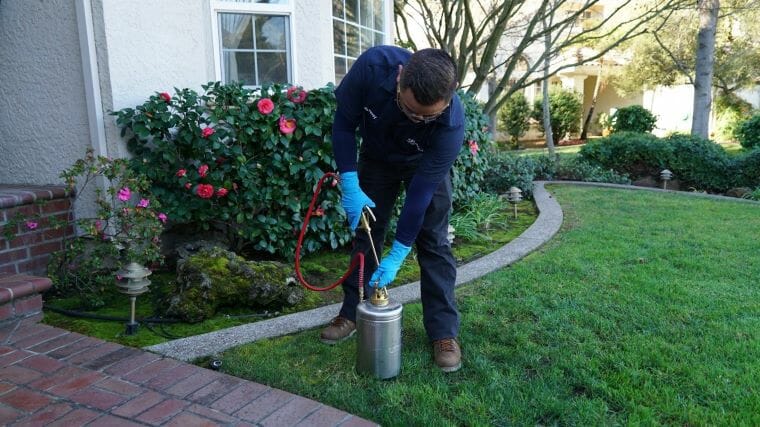
Professional teams like Smith’s know how to locate and eradicate roach infestations safely and effectively – without putting your kids, pets, or household at risk.
Here’s the process we follow at Smith’s:
Step 1: The Inspection
Our cockroach control experts will arrive at your property to inspect the infestation. We’ll look for areas where the roaches are accessing your home, and sources of moisture or food that may be enticing them.
We’ll also identify the species of cockroach you’re dealing with and formulate a plan for cockroach control.
Step 2: The First Treatment
Based on the information we gleaned during our initial inspection, we’ll develop a treatment plan for your home. Since cockroaches can be a difficult pest to eradicate, we take a two-step process to get rid of them.
Depending on the severity of your infestation, our preliminary treatment may include baiting, monitoring, trapping, or spraying the cockroaches or providing education, cleaning and sanitization services, or insect growth regulators.
During this step, we’ll place cockroach monitors to gauge activity.
Step 3: The Follow-Up Visit
Once we’ve deployed our initial treatment, we’ll check our monitors and deploy additional treatments as needed. The result is a complete end to your infestation – as quickly as possible.
Are Roaches Invading Your San Francisco Bay Area Home? We’re Here to Help!
Our team is here to help you get rid of roaches permanently. We provide top-quality cockroach control services to residential and commercial customers in Northern California – from Marin to Monterey.
Don’t settle for living with roaches – call our team for a free quote: (408) 871-6988
FAQ
What are cockroaches?
Cockroaches are insects that are members of the superorder Dictyoptera. While there are more than 4,500 roach species in the world, only about 69 of them live in the U.S.
Roaches are divided into two categories: peridomestic roaches and domestic roaches. Peridomestic roaches live around humans and tend to migrate inside when the weather gets cold. Domestic roaches, on the other hand, tend to live in human homes year-round.
What attracts roaches to my home?
- Food sources. Roaches are omnivores, meaning they’ll eat anything. They are particularly fond of starches, sweets, greasy food, and meats. Easy sources of food – like dirty dishes in the sink, pet food on the floor, or crumbs on the counter will draw them in. Roaches also love garbage, so make sure to take the trash out regularly and keep all household garbage cans tightly sealed. It’s important to know that roaches also eat all sorts of things we may not think of as food, including soap, hair, and toothpaste residue.
- Shelter. Cockroaches enter homes for shelter. During the day, they hide in dark, quiet areas that keep them safe. Depending on the species of roach, they may live behind picture frames, in hollowed-out wood, in damp places like beneath the sink or behind the toilet, or in the backs of your electronics. As the temperature dips outside, roaches will venture indoors. They love quiet, forgotten areas, and may live underneath large appliances, in the corners of basements, and the attic.
- Location. If you’re wondering, “Why do I have roaches in my clean house?” we understand. Solving a roach problem can be frustrating – especially if you’ve been careful to avoid common attractants. Unfortunately, some locations are just more appealing to roaches than others. Species like the American cockroach don’t need unsanitary conditions to thrive – they simply enter through a gap in a window seal or a door left open and start establishing themselves in your house.
- Moisture. Like all animals, roaches need water to survive – and they’ll enter even the cleanest and most sanitary homes to find it. Leaky pipes and faucets are common attractants, as are open showers and pet water bowls. Roaches will also gather in moist areas, like basements and crawl spaces.
- Landscaping. While roaches love to live inside, they’ll also enter your yard in search of food, shelter, and water. Standing water in birdbaths, gutters, and flowerpots will all attract roaches, as will food sources like bird seed or fruit plants.
What are the signs of roaches in my home?
You can identify cockroaches in your home by looking for a few telltale signs. One of the most common is the sighting of live or dead roaches in dark, humid areas such as the kitchen or bathroom.
You may also notice the presence of roach droppings, which are small and dark and resemble coffee grounds or black pepper.
Another sign is the presence of unusual, musty odors that are often associated with roach infestations. Cockroach egg cases, known as oothecae, may also be found in hidden areas, including behind furniture or appliances.
In some cases, you may find discarded roach exoskeletons, which can indicate a growing population. You may also hear rustling or scratching noises coming from inside walls or ceilings, as cockroaches are nocturnal creatures and are most active at night.
Other potential indications of an infestation include holes or gnaw marks on paper, cardboard, or furniture, smear marks, or damage to food packaging.
How do roaches get into homes?
The most common way roaches enter your home is through tiny cracks and gaps in windows, doors, and other areas.
Here are some of their favorite access points:
- Cracks and Gaps in Windows and Doors. Cracks and gaps in your home’s doors and windows are the top way roaches make their way into your home. Doors that aren’t sealed properly and windows that don’t close entirely are perfect access points for roaches.
- Holes in Pipes and Vents. Another common entrance point for roaches is through holes in pipes and vents. If you live in an older home with vents that have holes or aren’t properly sealed, it’s an invitation for roaches to come inside. Check your vents when you replace or service them, and keep an eye on pipes and plumbing fixtures for holes or other potential roach access points.
- Hitching a Ride on Furniture and Other Items. If you’re bringing used furniture or other items into the home, check them for roaches first. These insects can hole up and hide in used items, only to emerge once they’re safely inside your home. Roaches, especially the German kind, might be inadvertently brought into the home through personal belongings like backpacks. Investigate and interview household members to check if they are encountering cockroaches in other environments, such as at work.
- Outdoor Foliage. In some cases, cockroaches may use dirty gutters or outdoor vegetation to access entry points in a home, including vents and gaps and cracks around windows. Because of this, pest control professionals recommend creating a vegetation-free buffer around the home and eliminating foliage hanging over the house.




